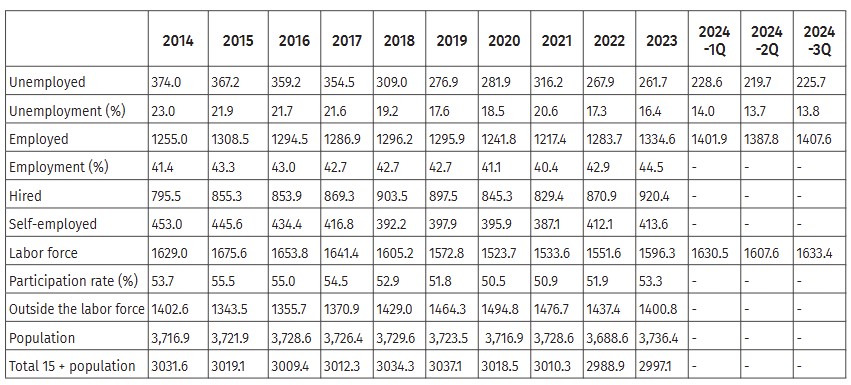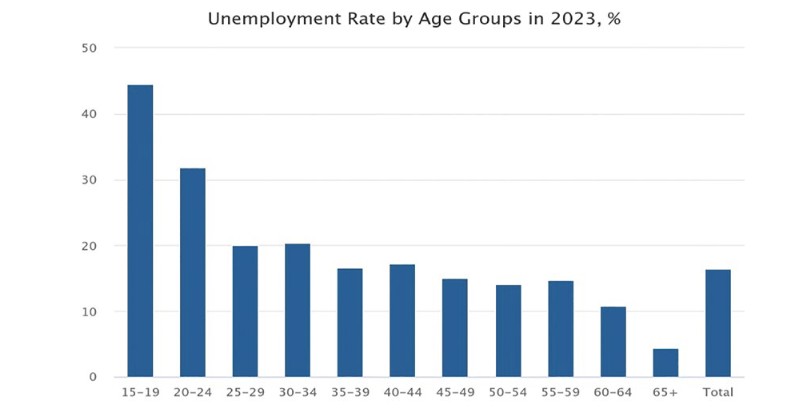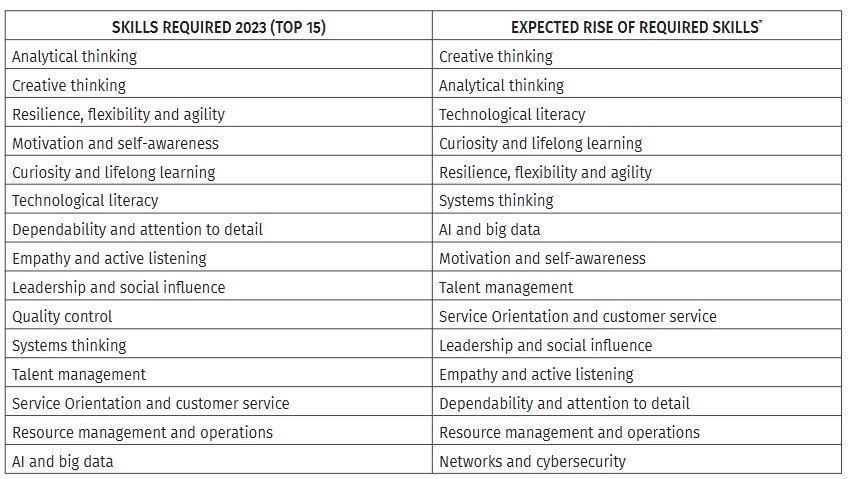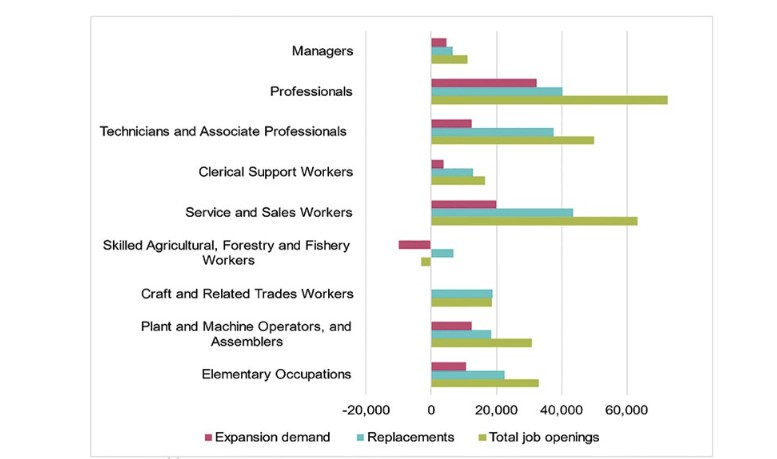Labour Market of Georgia: Overview and Anticipated Evolution
DOI:
https://doi.org/10.35945/gb.2025.19.004საკვანძო სიტყვები:
Future demands for skills and jobs, higher and self-employed, job creator macrotrends, employment and unemployment, drivers of changesანოტაცია
This study examines the trends and developments in Georgia’s labor market, with a primary focus on the period from 2013 to 2023. It is based on an analysis of current labor market conditions and relevant literature. The study identifies key drivers influencing the labor market, with particular emphasis on employers’ expectations. Notably, expanding digital access and the adaptation to advanced technologies are recognized as significant factors impacting the labor market. Additionally, the study outlines the most in-demand skills for the future workforce, which include creative and analytical thinking, technological literacy, systems thinking, expertise in artificial intelligence (AI) and big data, as well as competencies related to management, leadership, and cybersecurity. In the process of shaping future labor market policies, special attention is given to the influence of technological factors on the nature and roles of future work. The paper references studies that substantiate the growing impact of artificial intelligence on labor market dynamics. The conclusion emphasizes the necessity for coordinated approaches and strategies between labor market institutions and the education system to enhance labor market conditions and address existing and future skill mismatches. It is recommended that active labor market policies be grounded in a detailed and systematic study of anticipated labor market developments.
Keywords: Future demands for skills and jobs, higher and self-employed, job creator macrotrends, employment and unemployment, drivers of changes.
- Introduction
Reducing high unemployment rates and ensuring effective employment of the population requires the implementation of a comprehensive approach. To achieve these objectives, any policy, program, or project must involve a thorough study and analysis of the current state of the labor market. Furthermore, to ensure the desired outcomes, it is crucial to assess and forecast anticipated changes in the labor market.
Addressing issues related to unemployment and employment of the population is complicated by the fact that numerous factors influence the labor market. Labor markets in developing countries exhibit a unique dynamism, and Georgia is no exception. For over three decades, the labor market in Georgia has been characterized by high unemployment rates and ineffective employment strategies. A significant recent factor that has dramatically impacted Georgia’s labor market is the COVID-19 pandemic. Although there have been some positive developments in reducing unemployment during the post-pandemic period, the labor market continues to face substantial challenges.
Alongside a detailed study of the current situation, attention must be given to economic, technological, local, and global factors that may either exacerbate existing problems in Georgia’s labor market or, conversely, create new opportunities to improve labor market conditions. This is particularly relevant in the case of advanced technologies and digital work[1] platforms (Kvirkvaia, 2023). Therefore, it is crucial to conduct a comprehensive investigation into anticipated changes related to future skill requirements, labor market drivers, evolving workplace roles, strategies for preparing an adequate workforce, and other relevant factors.
- Methodology
This study aims to analyze the current state of the labor market, with a focus on the factors influencing its dynamics and the directions of its changes. Utilizing the desk research method, the study draws upon official statistical data, publications from local and international organizations, and research conducted by both foreign and Georgian scholars. This comprehensive approach ensures an in-depth examination of the labor market dynamics and the various influences shaping its future. Additionally, the study incorporates findings from the report[2] on the development of skills forecasting in the labor market of Georgia, created in collaboration with Cambridge Econometrics and the Ministry of Economy and Sustainable Development of Georgia (MOESD) (Suta, et al., 2022). Special attention is given to the study results published by the World Economic Forum, which are related to ongoing processes in global labor markets.
At the end of the paper, the research findings are summarized, and key conclusions are presented. This research serves as a foundational basis for a comprehensive study to be conducted on the labor market in the future.
- Overview of the Labor Market in Georgia
To analyze the current state of the labor market, the most critical indicators are the unemployment and employment rates of the working-age population. Monitoring changes over time is also essential to identify trends within the labor market. It should be noted that official data on workforce indicators is based on established methodologies and adheres to international labor statistics practices. The methodologies and standards employed by the country’s official agency in workforce studies are of paramount importance, as modifications of these methodologies and standards can lead to significant variations in the reported indicators. A good example of this is the introduction of new standards by the International Labour Organization in Georgia in 2020, which were implemented by the National Statistics Office of Georgia (National Statistics Office of Georgia, 2025). This change led to notable alterations in workforce indicators. While the relevance of official statistical data warrants separate discussion, for this research, official statistical data, along with other materials, provide valuable insights into the current state of the labor market in Georgia. One particular useful set of statistical information is the official data on population and workforce indicators[3] for the last ten years (see Table 1).
Table 1: Population and Labour Force Indicators*

(thousand persons)

Source: The table is compiled according to the data of the National Statistical Service of Georgia
Among workforce indicators, the most significant are the dynamics of unemployment and employment levels over the past 10 years. According to official data, the lowest unemployment rate recorded between 2014 and 2023 occurred in 2023, while the highest rate was observed in 2014. It is noteworthy that, according to official data, unemployment has been steadily decreasing since 2014, except during the COVID-19 pandemic period. During the reporting period, the absolute number of unemployed individuals decreased by 112,000, and preliminary official data for the first three quarters of 2024 indicate that the number of unemployed individuals has decreased even further. The unemployment rate varies significantly across age groups (see Figure 1). For instance, in 2023, the unemployment rate among young people aged 20 to 24 was notably high, reaching 32 percent, which is nearly double the overall unemployment rate for the country in the same year. Additionally, unemployment rates were also elevated among the 25-29 and 30-34 age groups, both exceeding 20 percent.
Figure 1
Source: National Statistical Service of Georgia
Unemployment and employment data categorized by educational attainment level can provide valuable insights into the labor market. Typically, these statistics illustrate how different levels of education influence job prospects and employment stability. Data from 2020-2023 indicate that the highest unemployment rate by educational attainment level is observed among individuals with Primary or Lower Secondary level, followed by those with Upper Secondary level. Next is Vocational education graduates, and the lowest unemployment rate is among individuals with Higher education.
According to official data, a positive correlation is confirmed between employment levels and educational attainment. From 2020 to 2023, it is evident that higher levels of education correspond to increased employment rates within the workforce.
Furthermore, employment levels among young people also vary by gender. For example, in 2023, the employment rate for graduates aged 20 to 34 was 54.8 percent. Within this group, the employment rate for women was 50.4 percent, whereas for men it was nearly 59 percent.
Over the past decade, the size of the workforce has remained relatively stable or has experienced a slight decline, with the participation rate being approximately 53 percent. During the same period, the number of individuals outside the labor force has also remained nearly constant. It can be assumed that the stagnation of both the labor force and those outside of it may be due to the low population growth rate and migration factors. Both phenomena are associated with numerous negative consequences for the population of Georgia.
A positive development is the increase in the number of employed individuals by approximately 80,000, primarily attributed to the rise in hired employees. However, the increase in the number of employees was mainly due to the growth in the public sector workforce, which does not guarantee long-term effective employment. This is confirmed by the data from the National Statistics Office of Georgia (2025) on the distribution of employment by ownership forms,[4] which indicates that employment across all sectors generally increased by approximately 12% from 2014 to 2023, including about 27% in the public sector, while in other sectors only by about 7%.
Despite a certain reduction, the number of self-employed people remains high (about 400 thousand). Likely, some of those self-employed individuals do not represent the actual employees or, at best, fall into the category of ineffective employees[5] (Kvirkvaia & Shengelia, 2024). Overall, the inefficiency of employment in Georgia is also reflected in the distribution of employees by type of economic activity, where the largest share is comprised of those employed in agriculture.
- Expected Changes in the Labor Market
In the context of globalization, the labor market of any country, including Georgia, evolves under the influence of international processes and changes. Therefore, to study the expected changes and development directions in the labor market, it is beneficial to consider the findings from research conducted at both international and national levels. In this regard, the fourth edition of the Future of Jobs[6] report, published by the World Economic Forum (2023), holds significant importance. This edition is based on a survey conducted across 45 countries, including Georgia. These countries’ economies account for 88% of the global GDP. The research covered 27 industry clusters and 803 companies, employing over 11 million people in total. The survey includes questions about broad trends and technology developments, their impact on jobs and skills, and the strategies businesses plan to implement to transform their workforce. The results of the research are based on the expectations of the surveyed companies regarding future changes in the labor market.
Since the demand for labor is derived from the demand for a firm’s output, changes in the labor market generally have a significant impact on businesses due to ongoing transformations. In terms of factors influencing business transformation, respondents in the Future of Jobs Report 2023 indicated that increased adoption of new and disruptive technologies, along with increased access to digital technologies, are likely to drive organizational change. These trends are expected to impact more than 86% of organizations surveyed. Among the factors driving changes within organizations, the broader application of Environmental, Social, and Governance (ESG) standards is also significant (80.6%). According to the respondents, the next most important trends in driving changes are macroeconomic trends, specifically the rising cost of living for consumers (74.9%) and slower global economic growth (73.0%).
The report presents the surveyed organizations’ assessment of individual macrotrends as job creators over five years. According to their expectations, the highest percentage of respondents identifies the macrotrend of increased adoption of new and frontier technologies as the most significant job creator. However, a significant portion of respondents also classify the same macrotrend as a job displacer. Therefore, despite the positive net effect of the increased adoption of new and frontier technologies on job growth, more significant net job creators in the future are anticipated to be investments that facilitate the green transition of businesses, the broader application of ESG standards, and the localization of supply chains.
In the World Economic Forum report, respondents from Georgia exhibit somewhat different expectations regarding job creators compared to the global perspective. For example, according to respondents from Georgia, the positive net effect (job creator minus job displacer) of the macrotrend of broadening digital access is 60%, whereas globally, the same indicator is almost half at 33.7%. Such differing expectations may be due to a relative lag in the adoption of digital technologies in Georgia compared to other countries. Nevertheless, Georgian respondents anticipate an increase in the utilization of digital technologies in the future and consider it a significant influencing factor on the labor market.
The impact of technology on the labor market is particularly noteworthy among macrotrends, as understanding how technology impacts labor markets is critical for facilitating transitions from declining jobs to future employment opportunities. The majority of surveyed organizations (75% and more) anticipate the adoption of technologies such as digital platforms and apps, education and workforce development technologies, big-data analytics, cloud computing, encryption and cybersecurity, e-commerce and digital trade, artificial intelligence, and so on by 2027.
In terms of the impact of technology on the labor market, particularly regarding job creation, the expectations for the next five years are almost identical both globally and in Georgia. Respondents from Georgia also consider e-commerce and digital trade, big-data analytics, distributed ledger technology (e.g., blockchain), encryption and cybersecurity, as well as digital platforms and apps, and so on, as significant job creators in the future.
Regarding the anticipated creation of new jobs in the labor market, forecasts for the demand for green jobs are significant. Specifically, according to a recent estimate by the International Energy Agency[7] (IEA), a green-recovery scenario could result in an additional 3.5% growth in global GDP, alongside a net employment impact of 9 million new jobs created each year. Globally, the green transition could create 30 million jobs in clean energy, efficiency, and low-emission technologies by 2030.
In order to adapt to future changes in the labor market, it is essential to identify the skills that will be increasingly in demand. More than half of the surveyed respondents recognize the basic skills whose importance is expected to rise between 2023-2027 (see table 3). Compared to the skills in demand in 2023, the importance of Creative and Analytical thinking will increase even more in the future.
Table 2: Required skills (2023-2027)

Authors elaboration. Source: World Economic Forum, Future of Jobs Survey 2023.
When comparing the two fundamental skills, creative and analytical thinking, respondents indicate that the importance of creative thinking is expected to grow more significantly in the future than that of analytical thinking skills. Nevertheless, both skills rank at the top of the list of the most important competencies for their respective periods. Additionally, respondents anticipate an increase in the importance of skills such as artificial intelligence (AI) and big data, systems thinking, technological literacy, curiosity and lifelong learning, motivation, and self-awareness, among others.
Forecasts regarding absolute job growth provide valuable insights. According to the Future of Jobs Report 2023, based on the study of 673 million employees using a global dataset of the International Labor Organization, the following forecasts are given regarding the absolute growth of jobs: Over the next five years (2023-2027), 69 million jobs will be created, and 83 million jobs will be lost. Thus, the study indicates a net loss of 14 million jobs, which constitutes 2% of the 673 million employees studied; According to the same study, the highest absolute job creation over the next five years is expected for Agricultural Equipment Operators, Heavy Truck and Bus Drivers, and Vocational Education Teachers. The greatest reduction in employment in absolute terms is expected for Data Entry Clerks, Administrative and Executive Secretaries, and Accounting, Bookkeeping, and Payroll Clerks.
To forecast changes in the labor market, it is crucial to comprehend the evolving division of tasks performed by humans compared to those executed by machines and algorithms. According to the Future of Jobs 2023 report, organizations currently estimate that machines perform over one-third of all business-related tasks, while humans handle the remaining nearly two-thirds. Employers anticipate that automation will exceed 40% by 2027. The survey indicates that by 2027, 35% of reasoning and decision-making tasks and 65% of information and data processing tasks will be automated. Furthermore, the study indicates that 44% of workers’ skills are anticipated to become obsolete within the next five years, according to surveyed companies. Survey participants estimate that 60% of workers will require training by 2027. In response to these changes, companies plan to prioritize learning initiatives, on-the-job training, and process automation. Most companies expect to see a return on their investment in skills training within a year, whether through increased productivity, enhanced employee satisfaction, or greater role flexibility.
In addition to the findings of the World Economic Forum’s research, numerous other papers and studies have highlighted the impact of technology on the labor market. Recent studies focusing on the short-term and long-term expectations regarding the impact of technologies, particularly artificial intelligence (AI), are particularly noteworthy. Regarding this, researchers (McRae et al., 2024) assert that “AI will create, not diminish, workforce opportunity”. A 2023 Gartner survey found that 22% of employees expected AI to replace their job within the next five years. Despite this anxiety, it is anticipated that, in the short to medium term, generative AI (GenAI) will not replace many jobs; rather, it will lead to the redesign of jobs to include new responsibilities, such as interacting with GenAI tools. “Gartner predicts that GenAI will be involved in 70% of text- and data-heavy tasks by 2025, up from less than 10% in 2023”.[8]
Furthermore, the International Labour Organization (ILO, 2024)[9] has placed significant emphasis on the impact of artificial intelligence on the labor market in its 2024 report. The report states, “Many countries, including developing ones, have adopted policies to encourage the adoption of AI. However, in the current climate of geopolitical tensions, technological transfer seems to be facing intensifying barriers, which will hamper leapfrogging strategies in developing countries to harness the benefits of these digital technologies”.
Researchers from Georgia (Abuselidze & Mamaladze, 2021) have dedicated a paper to examining the impact of artificial intelligence on the labor market and employment. According to their conclusion, “Artificial Intelligence can promote economic growth, create new jobs and employment. The destruction mechanism is a replacement effect, where new technology will replace old technology, and hence, changing old technology jobs will inevitably lead to unemployment. Technological advances will reduce costs and make resources more efficient”.[10]
Alongside certain global trends, there are labor market drivers that are specific to particular countries or regions. For instance, a group of authors (Hodge et al., 2023)[11] asserts that “The US labor market has experienced significant changes since the turn of the century. Some of the most profound changes were driven by technology, others shaped by business, policy, and shifting social norms. Two enormous economic shocks, the Great Recession of 2007–2009 and the pandemic recession of 2020, also drove change in the economy and labor market. At the time of this writing, the Federal Reserve has been working to bring down inflation rates that reached a 40-year high last year. These major developments have transformed the nature of work and opportunities for American workers”.
Based on the objectives of our research, among the recently published works and studies on the Georgian labor market, it is worth noting the report “Development of a Macroeconomic Skills Forecasting Model for Georgia” (Suta, et al., 2022). This report[12] was developed through a collaboration between the Ministry of Economy and Sustainable Development of Georgia and the international consulting company Cambridge Econometrics. Cambridge Econometrics was tasked with creating the skills forecasting model in close consultation with the National Bank and the National Statistics Office of Georgia. This document represents the first assessment of the future skills challenges facing the Georgian economy over the next five years (2022-2027). Based on the models developed within the framework of the work, a macroeconomic forecast is made in three key areas: the direction of labor demand (employment forecast by sector, occupation, and qualifications); the direction of labor supply (labor supply forecast by age, gender, and qualification); and replacement needs forecast by occupation. The models are constructed based on various assumptions. One such assumption is that by 2027, the working-age population (ages 15-64) will decrease by 12 thousand individuals. Under macroeconomic assumptions, starting in 2024, GDP growth is expected to remain stable at approximately 5% per year, with each major component of spending expected to grow at the same rate. According to this assumption, GDP is expected to increase by 30 percent by 2027 compared to 2022. Based on the sector growth estimates, the biggest sectors (for 2022-2027) are Agriculture, Manufacturing, Construction, Wholesale and Retail Trade, and Transport. Together, these five sectors are expected to account for nearly 60% of gross output.
Over the forecast period (2022-2027), employment in Georgia is projected to grow at an average annual rate of 1.3%. In absolute terms, this translates to an expected increase of approximately 10,000 workers per year. By 2027, employment in Georgia is forecasted to reach 1.36 million people, representing a 6.9% growth compared to 2022. Most sectors are anticipated to experience employment growth during this period, except for agriculture, which is expected to decline by over 11,000 workers. Declines are also expected in manufacturing. The employment decrease in Agriculture and Manufacturing can be attributed primarily to the robust growth in labor productivity within these sectors. Notably, the largest absolute increase in employment is expected in Public Administration and Defense, Transport and Storage, and Education. Additionally, smaller sectors like Mining and Quarrying and Activities of Households as Employers are expected to exhibit strong percentage growth.
The developed document contains critical information regarding the future labor market of Georgia, including anticipated job openings or vacancies. Two primary drivers of those directions are expansion demand* (resulting from changes in the size and structure of the economy); replacement demand (the need to replace people who may be leaving their current jobs). Forecasts of job openings are based on assumptions regarding changes in sectoral employment by occupation. Additionally, these forecasts consider trend analyses from countries similar to Georgia (such as Bulgaria and Romania), which have more readily available data, as well as expert estimates. The occupations considered are the nine ISCO 1-digit occupations (ILO, 2025).[13] According to the model developed in the report, in most occupations, replacement demand constitutes the majority of job openings. Overall, replacement demand and expansion demand are expected to account for 70% and 30% of job openings respectively (see figure 2). Productivity in the agriculture sector grows at a rate faster than output, the demand for Skilled Agricultural, Forestry, and Fishery Workers is expected to decrease, resulting in no anticipated job openings in that occupation. The occupations with the largest number of job openings coming from new jobs are Professionals and Service and sales workers, accounting for 25% and 21%, respectively, of total job openings. Furthermore, the Professionals category is where expansion demand accounts for the largest share of job openings (45%). The occupational structure of some sectors is kept unchanged due to a lack of evidence regarding potential future trends. As well as insufficient data on possible future trends.
Figure 2: Job openings by broad occupational group, 2022-27

Source(s): Cambridge Econometrics.
The paper outlines the expected labor supply based on age, gender, and qualification. It also compares labor demand by qualification to assess potential mismatches between skill supply and demand. Labor supply projections are based on population projections that do not consider any changes in labor force participation rates (by age and sex) for the period from 2022 to 2027. Consequently, the projected changes in labor supply are attributed solely to demographic shifts. The total labor force is expected to decline by approximately 66,000 individuals (2.5%) over the period from 2022 to 2027.
The report compares the projected supply (labor force) and demand (employment) across various qualifications and illustrates the future supply available (i.e., supply minus demand). These forecasts indicate a potential shortage of highly* qualified workers in the medium term. Consequently, middle-skilled workers may occupy high-skilled positions, while low-skilled workers, whose supply is expected to increase-may occupy medium-skilled positions, potentially leading to a skills mismatch that can impact productivity.
Conclusions
Analysis of the existing statistical data on Georgia’s labor market shows that the overall unemployment rate, particularly among youth age groups, is significantly higher than the natural rate of unemployment.
A positive development is that, according to official statistics, over the past 10 years, the number of employed individuals has increased, mainly due to a rise in the number of hired employees and a simultaneous decrease in the number of self-employed individuals. However, the number of self-employed individuals remains relatively high. Despite certain changes, the share of those employed in agriculture continues to be substantial. Regarding employment by sectors, over the past five years, the Georgian economy has experienced significantly higher percentage growth in the public sector compared to other sectors, which only provides a temporary alleviation of the unemployment problem.
Looking ahead, a shortage of highly qualified labor coupled with a surplus of low-qualified labor is expected to emerge alongside a reduction of the labor force. This situation will exacerbate existing mismatches in the future labor market.
In line with global processes, the primary factors influencing the development and changes in the Georgian labor market over the next five years will include expanding digital access, adaptation to modern advanced technologies, and projected economic growth. Additionally, other specific factors that will influence changes in Georgia’s labor market in the future include negative demographic and migration trends, as well as the prospect of joining EU structures etc.
The Georgian labor market is expected to experience increased demand for the following skills: creative and analytical thinking, technological literacy, systems thinking, expertise in AI and big data, skills related to management, leadership, and cybersecurity.
In developing labor market policies and programs in Georgia, it is essential to pay special attention to technological factors, such as artificial intelligence, which will influence not only the structure of employment but also the functions and roles performed by individuals in the workplace in the future.
To ensure effective employment, the primary focus should shift from the public sector to fostering growth in the private sector, as the private sector is poised to play a crucial role in providing long-term, effective employment opportunities.
Studying and forecasting the future development of the labor market should be prioritized as a pressing issue in the country. The primary users of labor market forecasts should be educational institutions (higher, professional, secondary). These institutions must provide an adequate labor market supply that aligns with the forecasted demand in a timely manner.
Decision-makers at the public level should facilitate the alignment of skills demanded and supplied in the labor market. They should also support the study of future labor market development. This must be part of active labor market policy.
To address the current and projected mismatches in the labor market in Georgia, labor market institutions and the education system should respond with a unified strategy and action plans to consider both global and local factors influencing the evolution of the labor market.
To quickly adapt to changes in the labor market, private companies should develop a flexible system of on-site education and training, thereby reducing reliance on external sources of labor supply.
Bibliography:
- Cambridge Econometrics (Belgium). Available at: <https://www.camecon.us> [Last Access: 01.12.2025];
- European Training Foundation. (2021). The future of work: New forms of employment in the Eastern Partnership countries: Platform work. Turin: ETF. Available at: <https://www.etf.europa.eu/sites/default/files/2021-07/future_of_work_platform_work_in_eap_countries.pdf> [Last Access: 01.12.2025];
- European Commission, Directorate-General for Employment, Social Affairs and Inclusion. (2021). Digital labour platforms in the EU: Mapping and business models: Final report. Publications Office. Available at: <https://data.europa.eu/doi/10.2767/224624> [Last Access: 01.12.2025];
- Gartner, Inc. Available at: <https://www.gartner.com>;
- Hodge, N., Andreason, S., Van Horn, E. C. (2023). The labor market, then and now: The first two decades of the 21st century, part one. Available at: <https://doi.org/10.29338/wc2023-02>;
- Howson, K., Ferrari, F., Salem, N., Johnston, H., Katta, S., Heeks, R., Graham, M. (2022). Driving the digital value network: Economic geographies of global platform capitalism. Global Networks, 22(4). Available at: <https://doi.org/10.1111/glob.12358>;
- International Energy Agency. (2020). World Energy Outlook Special Report in collaboration with the International Monetary Fund. Available at: <https://iea.blob.core.windows.net/assets/c3de5e13-26e8-4e52-8a67-b97aba17f0a2/Sustainable_Recovery.pdf>;
- International Labour Organization. (2024). World Employment and Social Outlook. Available at: <https://doi.org/10.54394/HQAE1085>;
- International Labour Organization. (n.d.). International Standard Classification of Occupations (ISCO). Available at: <https://ilostat.ilo.org/methods/concepts-and-definitions/classification-occupation/> [Last Access: 01.12.2025];
- Kvirkvaia, M. (2023). Digital work platforms in the modern labor market. In M. Kupiek & R. A. Brandmeier (eds.), The digital transformation of Georgia. Cham: Springer. Available at: <https://doi.org/10.1007/978-3-031-26451-1_1>;
- Kvirkvaia, M., Shengelia, M. (2024). Unemployment and Digital Labor Platforms in Georgia. European Scientific Journal, ESJ, 20(37). Available at: <https://doi.org/10.19044/esj.2024.v20n37p126>;
- Kvirkvaia, M., Kikutadze, V., Sikharulidze, D., Shaburishvili, S., Charaia, V. (2018). Study of factors affecting young people’s professional orientation in Georgia. Globalization and Business, 3(6). Available at: <https://doi.org/10.35945/gb.2018.06.035>;
- McRae, E. R., Aykens, P., Lowmaster, K., Shepp, J. (2024). 9 trends that will shape work in 2024 and beyond. Harvard Business Review. Available at: <https://hbr.org/2024/01/9-trends-that-will-shape-work-in-2024-and-beyond> [Last Access: 01.12.2025];
- National Statistics Office of Georgia. (2025). Labour Force Indicators. Available at: <https://www.geostat.ge/en/modules/categories/683/Employment-Unemployment> [Last Access: 01.12.2025];
- Suta, C.-M., Barbieri, L., Alexandri, E., Thoung, C., Barker, A. (2022). Development of a macroeconomic skills forecasting model for Georgia. Analysis of the labour market for the next 5 years. Cambridge Econometrics and the Ministry of Economy and Sustainable Development of Georgia. Available at: <https://www.lmis.gov.ge/Lmis/Lmis.Portal.Web/Handlers/GetFile.ashx?Type=Content&ID=2a982367-58a7-4744-93a5-14294b1ec451> [Last Access: 01.12.2025];
- World Economic Forum. (2023). Future of Jobs Report 2023. Available at: <https://www3.weforum.org/docs/WEF_Future_of_Jobs_2023.pdf> [Last Access: 01.05.2025].
Footnotes
[1] Kvirkvaia, M. (2023). Digital work platforms in the modern labor market. In M. Kupiek & R. A. Brandmeier (eds.), The digital transformation of Georgia, pp. 3-22. Cham: Springer. Available at <https://doi.org/10.1007/978-3-031-2641-1_1>.
[2] Suta, C.-M., Barbieri, L., Alexandri, E., Thoung, C., Barker, A. (2022). Development of a macroeconomic skills forecasting model for Georgia. Analysis of the labour market for the next 5 years. Cambridge Econometrics and the Ministry of Economy and Sustainable Development of Georgia (MOESD). Available at: <https://www.lmis.gov.ge/Lmis/Lmis.Portal.Web/Handlers/GetFile.ashx?Type=Content&ID=2a982367-58a7-4744-93a5-14294b1ec451> [Last access: 01.12.2025].
[3] National Statistics Office of Georgia. (2025). Labour Force Indicators. Available at: <https://www.geostat.ge/en/modules/categories/683/Employment-Unemployment> [Last Access: 01.12.2025].
* Table 1 presents some labour indicators for the first three quarters of 2024 only, published by the Office for National Statistics during the study period.
[4] National Statistics Office of Georgia. (2025). Labor Force Indicators. Available at: <https://www.geostat.ge/en/modules/categories/683/Employment-Unemployment> [Last Access: 01.12.2025].
[5] Kvirkvyaia, M., Shengelia, M. (2024). Unemployment and Digital Labor Platforms in Georgia. European Scientific Journal, ESJ, 20(37), p. 126. Available at: <https://doi.org/10.19044/esj.2024.v20n37p126>.
[6] World Economic Forum. (2023). Future of Jobs Report 2023. Available at: <https://www3.weforum.org/docs/WEF_Future_of_Jobs_2023.pdf>. [Last Access: 01.05.2025].
[7] International Energy Agency. (2020). World Energy Outlook Special Report in collaboration with the International Monetary Fund. Available at: <https://iea.blob.core.windows.net/assets/c3de5e13-26e8-4e52-8a67-b97aba17f0a2/Sustainable_Recovery.pdf>.
* Listed skills are ranked based on share of organizations surveyed which consider skills to be increasing in importance.
[8] McRae, E. R., Aykens, P., Lowmaster, K., Shepp, J. (2024). 9 trends that will shape work in 2024 and beyond. Harvard Business Review. Available at: <https://hbr.org/2024/01/9-trends-that-will-shape-work-in-2024-and-beyond> [Last Access: 01.12.2025].
[9] International Labour Organization. (2024). World Employment and Social Outlook. Available at: <https://doi.org/10.54394/HQAE1085>.
[10] Abuselidze, G., Mamaladze, L. (2021). The impact of artificial intelligence on employment before and during pandemic: A comparative analysis. J. Phys.: Conf. Ser. Available at: <https://iopscience.iop.org/article/10.1088/1742-6596/1840/1/012040>.
[11] Hodge, N., Andreason, S., Van Horn, E. C. (2023). The labor market, then and now: The first two decades of the 21st century, part one. Available at: <https://doi.org/10.29338/wc2023-02>.
[12] Suta, C.-M., Barbieri, L., Alexandri, E., Thoung, C., Barker, A. (2022). Development of a macroeconomic skills forecasting model for Georgia. Analysis of the labour market for the next 5 years. Cambridge Econometrics and the Ministry of Economy and Sustainable Development of Georgia (MOESD). Available at: <https://www.lmis.gov.ge/Lmis/Lmis.Portal.Web/Handlers/GetFile.ashx?Type=Content&ID=2a982367-58a7-4744-93a5-14294b1ec451> [Last Access: 01.12.2025].
* Expansion demand is calculated as employment in 2027 minus employment in 2022. Replacements is calculated as the total number of jobs where the person would need to be replaced over 2022-27. Total job openings is the sum between replacements and new/lost jobs.
[13] International Labour Organization. (n.d.). International Standard Classification of Occupations (ISCO). Available at: <https://ilostat.ilo.org/methods/concepts-and-definitions/classification-occupation/> [Last Access: 01.12.2025].
* High- Doctor or equivalent; Master or equivalent; Bachelor or equivalent; Higher professional education or equivalent. Medium- Secondary general education (upper secondary); Vocational education on the base of secondary general education (except higher professional education); Vocational education without secondary general education. Low- Basic general education (lower secondary); Primary education; Pre-primary education; Has no education but can read and write; Illiterate.
Downloads
ჩამოტვირთვები
გამოქვეყნებული
გამოცემა
სექცია
ლიცენზია

ეს ნამუშევარი ლიცენზირებულია Creative Commons Attribution-ShareAlike 4.0 საერთაშორისო ლიცენზიით .









